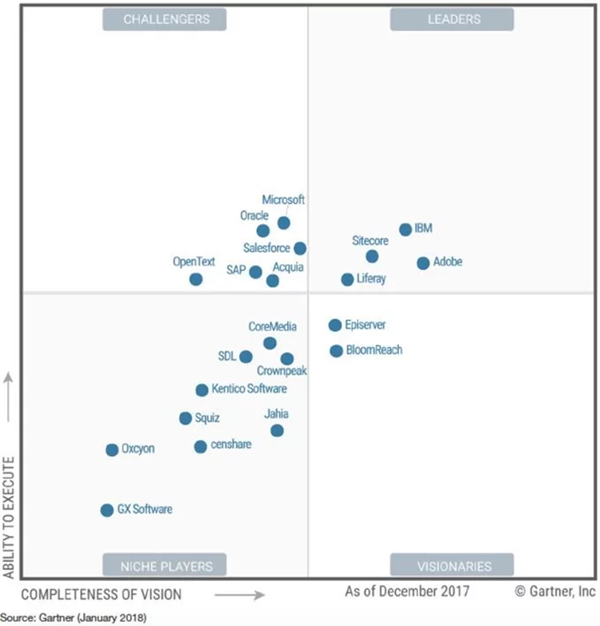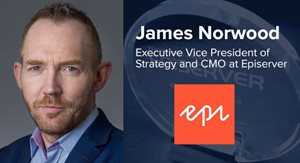Gartner Magic Quadrant for DXP 2018 ... Who's In Who's Out?
By Venus Tamturk
January 24, 2018
Acquia, Adobe, Digital Experience, Digital Transformation, Exclusive Interviews, gartner, Liferay, OpenText, Platform Review, sitecore
Four months after Forrester published its third Wave for Digital Experience Platforms, Gartner followed suit and published its first Magic Quadrant for Digital Experience Platforms last Wednesday. While the report has evolved from Gartner's Magic Quadrant for Horizontal Portals, there are significant differences with respect to the makeup of its vendors. As such, the new lineup of evaluated vendors includes those they have evaluated in previous Magic Quadrants for Horizontal Portals and those that would not have classically met the inclusion criteria of the Horizontal Portals reports - Acquia, BloomReach, Crownpeak, and SDL to name a few. There is more to discuss when it comes to what’s behind the change to the DXP Magic Quadrant and what that says about the industry as a whole but let me withhold that for now as those points will be discussed through the end of this article.
followed suit and published its first Magic Quadrant for Digital Experience Platforms last Wednesday. While the report has evolved from Gartner's Magic Quadrant for Horizontal Portals, there are significant differences with respect to the makeup of its vendors. As such, the new lineup of evaluated vendors includes those they have evaluated in previous Magic Quadrants for Horizontal Portals and those that would not have classically met the inclusion criteria of the Horizontal Portals reports - Acquia, BloomReach, Crownpeak, and SDL to name a few. There is more to discuss when it comes to what’s behind the change to the DXP Magic Quadrant and what that says about the industry as a whole but let me withhold that for now as those points will be discussed through the end of this article.
Another noticeable difference between the two reports is the market definition. The Stamford, Conn.-based research firm defines a digital experience platform (DXP) as "an integrated set of technologies, based on a common platform that provides a broad range of audiences with consistent, secure and personalized access to information and applications across many digital touchpoints. Organizations use DXPs to build, deploy and continually improve websites, portals, mobile and other digital experiences."
It sure must be fantastic for the vendors featured in the report to see their efforts recognized with a high valuation for consumers. However, how will their placement in the report impact their digital strategy as well as their product roadmap, and even more importantly, what does this recognition tell us as technology buyers? To find all of this out, I reached out to a handful of significant players in the space to inquire with them about their inclusion as well as the areas of improvement that the Gartner analysts cited in the report. Here's a glimpse into the 2018 Gartner Magic Quadrant for Digital Experience Platforms:

Leaders: Adobe, Sitecore, IBM, and Liferay
Sitecore
In October 2017, Sitecore rolled out a new Sitecore Experience Cloud, which is essentially the umbrella brand for its other three components which are Sitecore Experience Manager (web content management platform), Sitecore Experience Platform (digital marketing platform), and Sitecore Experience Commerce (digital commerce platform), and all three of these components have recently seen a major upgrade (Version 9). With version 7, the main focus was more on the technical features that mostly benefited IT users, whereas version 8 was all about empowering business users through an intuitive user interface. With the latest version, though, the primary focus is on providing marketers and merchandisers with accurate data and insights so they can deliver highly personalized omnichannel experiences.
Hot on the heels of the release of Gartner's report, I inquired with the Sitecore team on how they  feel about their positioning and how they intend on keeping up that momentum. “We made a strategic move to bring Digital Experience Platforms into the digital commerce arena, taking the position that a modern shopper expects more out of brands than transactions. Prioritizing an integrated customer + content approach produces better experiences, and we have a big head start coming from a digital experience heritage. This is optimal for teams looking to deliver a blend of physical and digital customer experiences,” said the Sitecore team and added: “Plus, without a commerce component, brands have difficulty knowing who their customers are. Customers who are succeeding and setting new standards for experience in their industries are the best confirmation of our efforts.”
feel about their positioning and how they intend on keeping up that momentum. “We made a strategic move to bring Digital Experience Platforms into the digital commerce arena, taking the position that a modern shopper expects more out of brands than transactions. Prioritizing an integrated customer + content approach produces better experiences, and we have a big head start coming from a digital experience heritage. This is optimal for teams looking to deliver a blend of physical and digital customer experiences,” said the Sitecore team and added: “Plus, without a commerce component, brands have difficulty knowing who their customers are. Customers who are succeeding and setting new standards for experience in their industries are the best confirmation of our efforts.”
When it comes to those efforts, besides providing Commerce, Content & Consumer Data in one platform and Native Experience Database for real-time personalization, Sitecore believes that their efforts to foster its community also helped them land in the “Leader” quadrant. To name a few Sitecore’s community activities to engage with its customers and partners - customer visits for their requirements, local user group events with over 3,000 attendees, their annual symposium, MVP Program recognition for top contributing professionals in Commerce, Development, and Digital Strategy, and having offices in 19 countries to deliver localized care and attention.
Previously, some analysts were critical of Sitecore’s cloud strategy as they claimed that the vendor has fallen behind its competitors in their shift to the cloud. However, their expansion of a longstanding partnership with Microsoft has built a solid ground for their ongoing winner cloud strategy, and with the latest major product upgrades, the vendor won Gartner's heart, once again.
That being said, not all of the market research firm’s comments cited about Sitecore in the report are rosy. “Some Sitecore customers report dissatisfaction with the quality and effectiveness of the vendor's customer support and professional services,” stated Gartner’s analysts so I asked the team if there are any future plans or ongoing projects to address this growth opportunity.
Here’s what they had to say: “Sitecore has made a number of improvements to its partner program to place an even greater emphasis on customer success. Among these efforts, Sitecore is implementing a formal Customer Satisfaction Program, launching partner onboarding and specialization programs, and standardizing business planning and performance management. In addition, partners across geographies and market segments will be appropriately matched with alliance and technical account management, programmatic support, and advisory services. For customers who develop in-house without a partner, Sitecore Technical Account Managers (TAM) bring additional technical expertise to projects that demand unique product insight or guidance. TAMs attach directly to a customer’s implementation and/or maintenance team, provide a single point of contact for all Sitecore-related inquiries, and help customers reduce project risk by involving Sitecore actively and directly in their project plans.”
Last but not least, the Sitecore team shared the key emerging industry innovations they see: "The DXP market is in a phase of consolidation and rationalization. After years of feature growth, the ability to shorten time to value is growing in importance as customers look for simpler, quicker deployments (and more of them), and reduced complexity in their solutions to drive more agility in their customer facing programs. Tools like Sitecore Experience Accelerator will help reduce complexity and accelerate customers' time to value via the opportunity to create capabilities in their initial phase of their deployments instead of waiting for “phase 2,” while machine learning technologies such as Sitecore Cortex will help deliver contextualized experiences that are more intelligent, engaging, and discoverable."
"Likewise, integrations to line-of-business and other customer-facing applications will continue to be critical for customer success. The “usability and consumability” of customer information in the moment of engagement is critical to a real-time understanding of what is (or is not) going on with their customer interactions, regardless of where they happen. Marketing technologies that work from a single data repository—enabling all customer data to work across the organization— will offer marketers the real capability to understand where customers stand in their journey and how to build customers for life. That is precisely the value behind Sitecore xDB and Sitecore xConnect: not just collecting customer data, but connecting it from every customer interaction—both online and offline—and making it available to marketers (and sales, customer service agents, and other internal users), in real-time and at scale, for automated interactions across all channels that shape the customer experience. Similarly, we also foresee a tighter coupling of content delivery and commerce, giving organizations the ability to not only engage customers beyond standard nurture campaigns, online catalogues, and orders, but also personalize and optimize promotions, automate contextualized engagement in an omni-channel fashion, and validate the success of their customer engagement programs."
"Last but not least, businesses will focus on vendors that deliver people, process, and technology with a sharp focus on the customers' needs. Technology is the enabler but, based on the maturity of most organizations, we need to take an active part in advising them on the right processes and roles (and breaking down some of the barriers to doing this) that will help them be more customer-focused. That means vendors and partners must focus on integrating best practices directly into their products, providing strong methodology and delivery governance from the vendor’s ecosystem, and creating customer success programs that bring vendors even closer to customers on an ongoing basis."
LIFERAY
Liferay has been a Leader for the past seven years in the Magic Quadrant for Horizontal Portals. In fact, the vendor is one of just two vendors who retained their spot as a Leader in the change to the DXP Magic Quadrant. In 2016, Liferay shifted its platform from a portal software to digital experience platform. The foundation of Liferay DXP remained as the portal platform itself but the vendor added built-in integrations with a number of backend systems including CRM, ERP, support, and other systems. As a matter of fact, because of its portal heritage, Liferay has deep integrations with many backend business systems. In my view, having this kind of backbone puts the vendor ahead of its rival in the space. On top of all these, the platform has also been designed to utilize a microservices approach to give users flexibility to add more capabilities when needed.
Circling back to the MQ, you may purchase the report to read Gartner’s review of Liferay Digital Experience Platform (formerly Liferay Portal Enterprise Edition). However, speaking to CMS-Connected, the industry veteran Bryan Cheung, Liferay CEO, made very interesting points about the evaluation of the digital experience market.
Experience Platform (formerly Liferay Portal Enterprise Edition). However, speaking to CMS-Connected, the industry veteran Bryan Cheung, Liferay CEO, made very interesting points about the evaluation of the digital experience market.
First, Cheung defined a DXP from a Liferay standpoint: “We believe a digital experience platform is technology that engages and unifies the entire enterprise to deliver better customer experiences. DXPs do this by bringing together key functional areas—content, commerce, integration, and analytics—in a single platform that makes it easy to build personalized, digital touchpoints for users throughout their journey.” He also added that they are pleased that Gartner has identified Liferay “as a platform with a portal heritage that has grown to be much more than a portal, keeping pace as today’s digital business needs evolve.”
When it comes to what this year’s MQ for DXPs says about the industry as a whole, he explained: “In our view, this shift in Magic Quadrant focus from portals to DXPs is a natural progression in step with today’s digital business imperative for exceptional experiences. Portals helped integrate systems and provide personalized but secure access, but they were driven by enterprise IT needs. Business now needs integration and personalization, because their interactions with customers are digital in nature. They need the technology that portals have, but portals have also had to evolve to be more business-savvy, solving business user needs more innately through the platform. That's what DXPs accomplish.”
Lastly, he talked about the key industry trends on the horizon: “We’ve seen a rise in businesses requiring foundational technology capable of serving customers across all the varied interactions with the organization –for example tying together the customer call center with a customer self-service portal or a loyalty site. This need to unify extends to the enterprise level, where companies want to build their intranet, customer portal and websites on a single foundation. While we don’t believe any one software will meet all the needs of a digital business, we do believe it’s critical to deliver experiences that make sense and are connected from one interaction to another, and that’s where the power of a digital experience platform comes in.”
“Today’s businesses wants more analytics, increased agility, and a way to use the cloud to respond to the customer faster. There’s less emphasis on mobile as a standalone channel. We also see businesses increasingly coming to the realization that digital marketing-only or SaaS-only approaches can only take them so far. A deeper commitment to digitizing core business processes or models is necessary for real change that truly serves the customer.”
ADOBE
Of all the vendors evaluated in the report and among four vendors in the Leaders quadrant, Adobe was furthest to the right for completeness of vision, where evaluation criteria includes market understanding, marketing strategy, sales strategy, offering (product) strategy, business model, vertical/industry strategy, innovation and geographic strategy.
In my view, Adobe is one of very few vendors that have ridden the crest of the cloud shift as it executed such a smooth and successful shift for desktop software and its software development process. The vendor is also well-known for having been investing a lot of its resources into the best and quickest way to innovate and disrupt the industry.
In March 2017, the San Jose, California-based vendor rolled out a new umbrella product, called Adobe Experience Cloud that is comprised of Adobe Marketing Cloud, Adobe Advertising Cloud, and Adobe Analytics Cloud. Around the same time, the vendor also made a direct integration between Adobe Creative Cloud and Adobe Campaign in order to save marketers and organizations time as well as the pain of going back and forth with their internal agencies. In conjunction with the release of Adobe Experience Cloud, Adobe and Microsoft announced the availability of their first set of joint enterprise solutions focused on transforming customer experiences. This tightened partnership allowed Adobe to broaden its footprint from midmarket organizations to more roles and functions of larger enterprises. Adobe also announced a Fluid Experiences for Retail capability through its web content management system, Adobe Experience Manager, in order to enable retailers to create and manage omnichannel experiences across any touchpoint, including in-store associate apps, social channels, physical signage, Internet of Things (IoT) devices, and smart-screens.
Speaking to CMS-Connected, Adam Justis, Director of Product Marketing for the Adobe  Experience Cloud at Adobe, had told us: “Adobe has already a great reputation knowing what they are doing in the space of content, and on top of that, the platform allowed people to fuse content and insight together so not only they have insights but also they are able to take actions on those insights and have a meaningful way of delivering those compelling experiences.” He also added: “That kind of continuum helped Adobe get recognition for being able to enable our customers to satisfy their customers in the digital age.”
Experience Cloud at Adobe, had told us: “Adobe has already a great reputation knowing what they are doing in the space of content, and on top of that, the platform allowed people to fuse content and insight together so not only they have insights but also they are able to take actions on those insights and have a meaningful way of delivering those compelling experiences.” He also added: “That kind of continuum helped Adobe get recognition for being able to enable our customers to satisfy their customers in the digital age.”
Just like all DXP vendors, Adobe also has room to grow. One of those key areas of growth is targeting all DXP use cases across industries, according to Gartner. I wanted to inquire if there any future plans or ongoing projects to address this growth opportunity, however, Adobe wasn't available to comment on that.
Challengers: Microsoft, Oracle, Salesforce, Acquia, SAP, and OpenText
OpenText
OpenText, a Canadian enterprise information management vendor, offers DXP functionality through its DAM, WCM, customer communications management and workforce optimization capabilities. The umbrella product for all these capabilities is OpenText Experience Suite and the platform is designed to help OpenText customers harmonize customer-centric technology applications across every department in the organization, whether the organization’s first priority is to get a handle on all of the rich media (video, audio, print, imagery, etc.) or to streamline its communications, invoices, or web presence.
Speaking to CMS-Connected ahead of Gartner’s report, Marci Maddox, senior director of  product marketing, CEM, at OpenText, shared how OpenText feels about its positioning: “The recognition from Gartner is a testament of OpenText’s commitment to enhancing and integrating our key platforms and delivering optimal digital experiences for our customers, especially in the areas of content management, collaboration, workflow and analytics. OpenText continues to develop the OpenText Experience Suite to deliver a unique portfolio of products that covers the complete customer journey from engagement to insight.”
product marketing, CEM, at OpenText, shared how OpenText feels about its positioning: “The recognition from Gartner is a testament of OpenText’s commitment to enhancing and integrating our key platforms and delivering optimal digital experiences for our customers, especially in the areas of content management, collaboration, workflow and analytics. OpenText continues to develop the OpenText Experience Suite to deliver a unique portfolio of products that covers the complete customer journey from engagement to insight.”
She also explained how they intend on keeping up that momentum: “We’re pleased that Gartner recognized that our overarching goal of providing a continuous connected customer journey, which drives all of our innovation and helps keep our customer needs front and center. We are also proud that our continued investment and work to offer a wide breadth of functionality – especially across communications and the contact center – was seen to be a level rarely matched by our competitors. These are areas which are important to customers, and it’s great to have industry validation on our strategy and innovation.”
In the report, Gartner touched upon “a lack of innovation and stagnant development in relation to OpenText's older acquired offerings.” The Waterloo, Ontario-based enterprise information management provider is on the cusp of a major integration of acquired WCM and Customer Communications Management (CCM) assets from HP Inc.'s. In my view, we will see an innovation wave engulfing those older acquired assets in 2018 and beyond. However, I wanted to get an inside scoop on the matter and asked Maddox if they have any ongoing projects to satiate this interest. She explained: “OpenText continues to invest in its DXP capabilities to ensure its wide range of customers will see integrated, innovative and modernized offerings, to support a digital transformation. In November, we released our EP3 update for OpenText Experience Suite, which aims to make it easier for organizations to create compelling and engaging experiences to streamline the customer journey and maximize sales interactions. With all our technology integrations, we provide our customers with a detailed roadmap to ensure that every customer is positioned to make the most of our continued innovation.”
Maddox also outlined which products we will see the most innovation in the coming months: “Recent updates in the Web Content Management (WCM) and Customer Communications Management (CCM) products demonstrated that there is active development and road maps in place with continued innovation around the Experience Suite platform. This includes the latest investment to bring together StreamServe, PowerDocs and Exstream as a single modern CCM platform under the Exstream brand. OpenText has an active customer community that influences the new product features for the older acquired offerings as part of a regular six-monthly release cycle.”
Due to her expansive experience in the field, I wanted to pick Maddox’s brain on the significant industry trends. “In an increasingly digital world, organizations are producing an overwhelming amount of data on a daily basis. We see the greatest potential in the growth of Artificial Intelligence (AI), such as OpenText’s Magellan platform, Intelligent Automation, with process and journey orchestration, Identity Access Management and micro-services to combine quantitative and qualitative data to analyze customers’ behaviors and motivations. This will allow companies to optimize key customer journeys, predict future behavior and evaluate opportunities to boost retention, enrichment, and loyalty. Also look to see a heavier emphasis on the intersection of DXP and content management, as sharing and collaboration become an integral factor for organizations to remain competitive. Organizations will evaluate existing investments in DXPs based on their access to insights for better decision making across the business. Innovation will be sourced from rapidly adopted and evolving technologies such as AI, automation, and IoT to keep up with market demands,” Marci Maddox said.
ACQUIA
Acquia has taken Drupal to the enterprise level by its strong commitment to “delighting their customers and providing the best digital experiences in the world.” Its innovative cloud platform deeply rooted in open source has been landing Acquia on nearly every short-list in the open-source community. Its winning strategy that focused on API-first delivery and secure cloud deployment as well as their core focus of customer success are the primary factors behind Acquia’s unprecedented growth. From education sectors to consumer products, the Acquia Cloud platform caters to the needs of a wide range of industries.
Just before 2017 came to a close, the vendor named Michael Sullivan as their new CEO, who was responsible for managing over 30 SaaS products at both Micro Focus and with Hewlett Packard Enterprise. Sullivan’s 25-year senior leadership in SaaS, enterprise content management, and content governance is expected to guide Acquia in its transformation from a single product company to a multi-product company as the vendor outlined a goal to move from website management to data-driven customer journeys. With their focus on providing data-driven customer journey solutions in mind, Acquia announced two new products that support this goal: Acquia Journey and Acquia Digital Asset Manager (DAM).
Circling back to the MQ report, I reached out to the newly appointed CEO to go more in- depth on their placement in the report. “It’s clear our team is really passionate about the work we do for our customers, and that passion drives our success. In our first decade, Acquia pioneered cloud-based, open source content management. As we embark on the next decade, we’re already underway in building the pre-eminent platform for digital experience management. Our developers and engineers are intensely focused on creating solutions to solve the biggest challenges in digital experience delivery today,” said Sullivan.
depth on their placement in the report. “It’s clear our team is really passionate about the work we do for our customers, and that passion drives our success. In our first decade, Acquia pioneered cloud-based, open source content management. As we embark on the next decade, we’re already underway in building the pre-eminent platform for digital experience management. Our developers and engineers are intensely focused on creating solutions to solve the biggest challenges in digital experience delivery today,” said Sullivan.
One of the specifics that Gartner analysts think would improve the platform is the underdevelopment of the integration and aggregation capabilities required by some DXP use cases, comparing to some other vendors. Sullivan commented on the direction of the market, first: “The digital experience space is still in its early formation, and the market’s expectations for DX solutions are still being defined. We know our focus is squarely on the most pressing and in-demand challenges for digital experience management.”
He also directly addressed Gartner’s feedback: “In recent months Acquia dramatically expanded the capabilities of the Acquia Platform, building upon its Drupal-tuned cloud platform with multisite management and personalization solutions to add support for Node.js, data-driven customer journeys, and digital asset management. The timing of Gartner’s report was such that these new products weren’t part of Gartner’s consideration.”
“We’re increasing our R&D investments in 2018 and growing key integrations with our platform, developing our use of AI, advancing our machine learning capabilities, and adding functionality to create a great experience for marketers and to help developers build faster. We’ll continue to hit new DX milestones in 2018 for our customers.”
When we look over the horizon, Sullivan sees a seamless customer experience across all the channels that brands captivate on as the secret sauce for getting an upper hand: “There’s a great deal of focus on empowering content teams and marketers to create immersive and personalized experiences across every medium. Digital experiences span mobile devices, digital signs, chatbots, artificial intelligence, and even augmented reality. The organizations that create bonds of consistency in how people interact across these mediums will win the day.”
SALESFORCE
In the report, Gartner reviews Salesforce Community Cloud by referring to the platform as “the centerpiece of Salesforce’s DXP strategy.” Salesforce Community Cloud is widely adopted among businesses which are looking to meet the needs of customers in food and beverage, manufacturing, health care, automotive, airline and nonprofit industries. This cloud-based enterprise community platform includes Sales Cloud, Service Cloud, Chatter, Force.com custom applications, search, identity, workflow, Lightning and APIs.
An infamous Austin, Texas-based outdoor brand has recently made a headline in the news due to its rapid growth through its new digital store in the cloud. The company stated that they have been able to manage omnichannel customer journeys of their B2C and B2B audiences at scale using Salesforce Sales Cloud, Service Cloud, Marketing Cloud and Community Cloud. With the platform, not only are shoppers able to receive unique content, campaigns, offers and recommendations based on information such as past purchases, geographic regions and even their favorite outdoor adventures; but also they can now design their own custom orders, mix and match drinkware and more without having to leave the commerce site.
While Gartner’s reference customers continued to report overall high satisfaction levels with the Salesforce Community Cloud, Gartner also cited: “Salesforce Community Cloud lacks sufficient WCM functionality for some DXP use cases.”
James Norwood Explains the Differences between Gartner’s vs Forrester’s DXP Reports
Episerver has been positioned as a visionary in Gartner's Magic Quadrant for Digital Experience Platforms. "Although the market for digital experience platforms is still maturing, we're seeing more organizations undergoing the rigors of digital transformation within their business, for which the potential of a DXP is increasingly the answer," said James Norwood, executive vice president, strategy and CMO at Episerver in a press release. Due to all of the transparency we know him for, I reached out to James Norwood to discuss the report.
First, knowing there has been a lot of controversy around the latest Forrester Wave on DXPs in  terms of their underlying criteria, I was curious to hear Norwood’s take on the differences and what the criteria of this year’s MQ for DXPs say about the industry as a whole. Norwood said: “Gartner and Forrester are quite rightly drawing attention to the maturing nature of customer experience delivery, and although buyers typically don’t refer to the technology that enables this as a DXP per se, in many cases that’s what they’re looking for. However, what’s clear is that there is still no agreed-upon definition of a DXP in the market. This is why you see leaders in the Gartner Magic Quadrant positioned as 'Challengers' in the Forrester Wave.”
terms of their underlying criteria, I was curious to hear Norwood’s take on the differences and what the criteria of this year’s MQ for DXPs say about the industry as a whole. Norwood said: “Gartner and Forrester are quite rightly drawing attention to the maturing nature of customer experience delivery, and although buyers typically don’t refer to the technology that enables this as a DXP per se, in many cases that’s what they’re looking for. However, what’s clear is that there is still no agreed-upon definition of a DXP in the market. This is why you see leaders in the Gartner Magic Quadrant positioned as 'Challengers' in the Forrester Wave.”
Speaking to CMS-Connected, Norwood also commented on what the shift in Magic Quadrant focus from portals to DXPs means to technology buyers and vendors: “The shift actually reflects the changing needs of technology buyers, and vendors should take note. Organizations of all kinds are increasingly looking for broader platforms that can seamlessly interoperate with existing systems and accommodate new and potentially disruptive processes and experiences as well, and the concept of a DXP can provide a centerpiece for this. However, what you’re seeing is that with Gartner’s evolution from horizontal portals to DXP, there’s less emphasis on digital commerce and more focus on B2E and B2B scenarios, whereas with the Forrester Wave, digital commerce is seen as a more fundamental component of a DXP as are B2C scenarios. These are subtle differences, but they can potentially confuse buyers."
My POV
In the ideal world, the premise of these industry reports is to guide companies that are in the process of evaluating a specific solution to develop the most effective and efficient digital ecosystem for their business by providing an in-depth analysis of leading vendors. Now, in reality, I don’t know for sure whether this is still the only intention behind migrating those little dots around or there are additional financial concerns involved in the process. However, instead of going down that road and discussing the ethics of market research reports, I would like to recommend buyers aim to find the best match rather than simply the best product if they want to maximize their every digital investment dollar’s effectiveness.
As mentioned in my opening paragraph, the shift in Magic Quadrant focus from portals to DXPs tells us about the evolution of digital business. The role of portals, which were historically used for elementary knowledge sharing of a single piece of static electronic information to a large public audience, has evolved, from delivering records and information to providing a way to engage the audience and tailor content on a one-to-one communication scale to create a fully integrated 360-degree ecosystem.

Today, on one hand, digital savvy technology buyers are looking for best-of-breed solutions that support digital experiences in diverse use cases, such as the IoT, conversational interfaces, or embedded commerce, on the other hand, some buyers are looking for a single-vendor solution where organizations can connect every step of a multichannel, multi-location business while all the capabilities from DAM, WCM, customer communications management to workforce optimization capabilities are in one place. To be able to speak to both buyer personas, DXP vendors persist to amplify their native capabilities in emerging areas such as e-commerce and contextual marketing features, while providing solutions which can seamlessly integrate with different sets of third-party technologies in order to give their users ultimate flexibility. Therefore, they all keep innovating, acquiring, and teaming up to make those platforms more modular, granular and atomic.
Even though it creates a large potential for value and profitability, the configuration of platform ecosystem is one of the key tasks in a platform economy. It may represent a huge challenge and requires a strong commitment. However, platform-based ecosystems are fuel for innovation for many technologies, products, and services in the global economy. Therefore, many businesses focus more on the creation of new business models by integrating ecosystems of people, business, and things. This is, unfortunately, easier said than done as organizations need a paradigm shift in perspective, away from the traditional supply-demand economic perspective.
Related Gartner News

Venus Tamturk
Venus is the Media Reporter for CMS-Connected, with one of her tasks to write thorough articles by creating the most up-to-date and engaging content using B2B digital marketing. She enjoys increasing brand equity and conversion through the strategic use of social media channels and integrated media marketing plans.